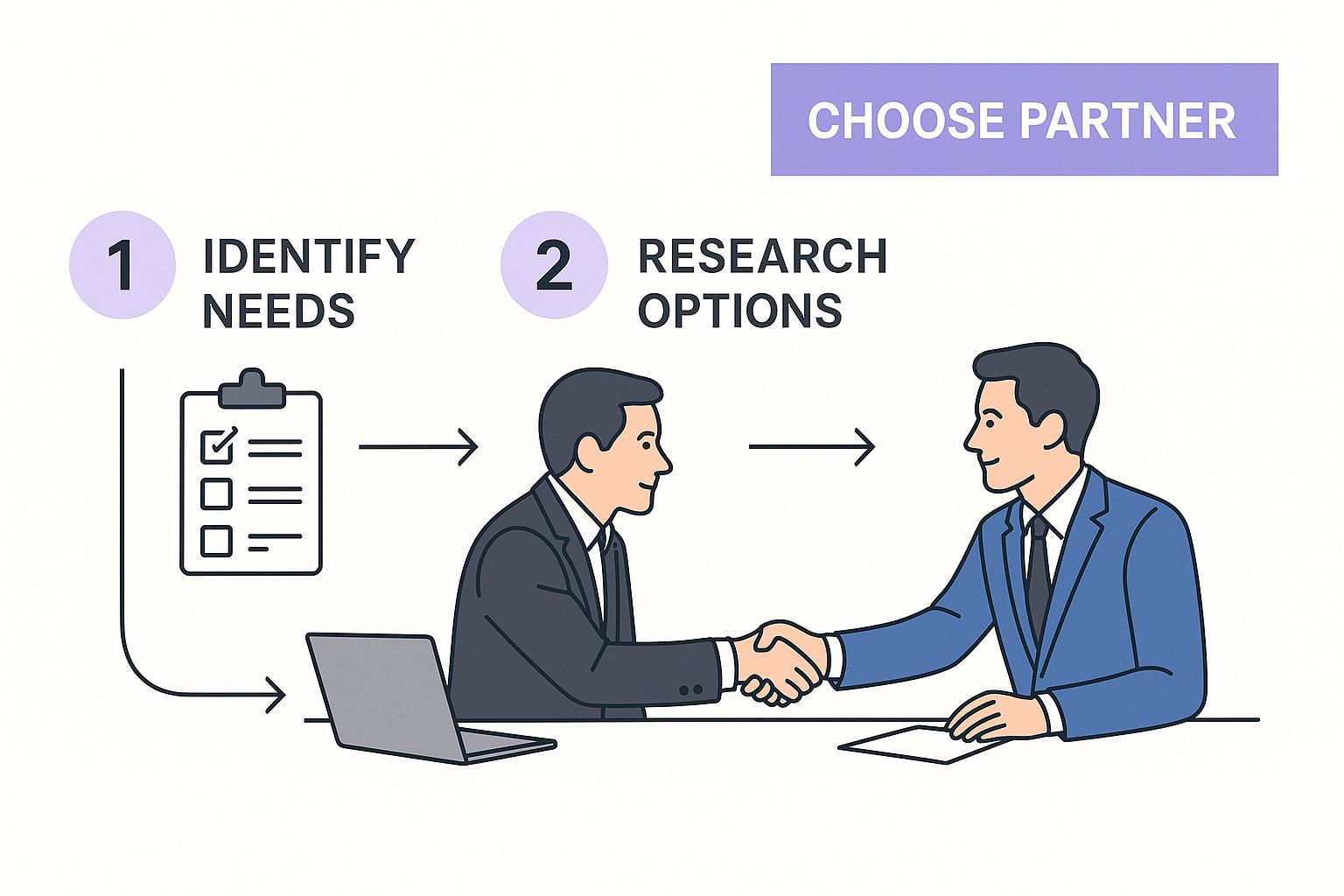
Deciding to outsource Python development is far more than a simple cost-cutting tactic. It's a strategic pivot that unlocks immediate access to a global pool of specialized talent. This approach lets you sidestep the long, expensive slog of building an in-house team, getting your projects off the ground faster and with the right experts from day one.

Many leaders first look at outsourcing through the narrow lens of saving money. And while the cost-efficiency is undeniable, the real win is in strategic agility—getting top-tier skills on demand, exactly when you need them.
Building a full-time, in-house Python team comes with a mountain of hidden overhead that goes way beyond salaries. These overlooked costs can quickly sink your budget and stretch your timeline.
The business case for outsourcing becomes crystal clear once you honestly tally up the total cost of an internal team. The process is painfully expensive and slow, with expenses piling up across recruitment, management, and retention.
Python developers are some of the most sought-after pros in tech, and specializing in high-demand frameworks like Django or Flask sends their salary expectations even higher. In our experience, building a domestic team can easily double or triple project costs compared to partnering with a vetted external provider. You can read more about the cost advantages of outsourcing on OrientSoftware.com.
Before you commit to hiring internally, take a moment to compare the real-world expenses. The numbers often tell a compelling story.
| Cost Factor | In-House Team | Outsourced Team |
|---|---|---|
| Recruitment | High fees (15-25% of salary), extensive time investment | Minimal to none; covered by the partner |
| Salaries | Top-tier market rates for competitive talent | Lower, based on global market rates |
| Benefits | Health insurance, 401(k), paid time off, etc. | Not your responsibility; handled by the partner |
| Equipment | High-performance laptops, monitors, software licenses | Included in the service or a small, one-time fee |
| Office Space | Rent, utilities, and furniture per employee | Zero; developers work remotely |
| Training | Continuous budget for courses and certifications | Included; partners invest in their team's skills |
| Onboarding | Weeks or months of ramp-up time and lost productivity | Days; experts are ready to contribute immediately |
As the table shows, the initial salary is just the tip of the iceberg. The cumulative effect of these "hidden" costs is what makes outsourcing such a financially sound and strategically agile decision.
By sidestepping the traditional hiring cycle, you not only save money but also gain a critical competitive edge: speed. Instead of spending months finding and onboarding talent, you can have a team of experts building your product within weeks.
Ultimately, outsourcing Python development is about gaining operational flexibility. It empowers you to scale your development muscle up or down based on project demands, without the heavy commitment of full-time employment.
This transforms your development budget from a fixed overhead into a dynamic, powerful resource. You can confidently tackle ambitious projects—from AI-powered analytics to complex web applications—by tapping into specialized expertise that might be unavailable or just too expensive in your local market.
It’s not just about saving money; it’s about investing in a smarter, more adaptable way to build and innovate.

Before you even think about writing a job description or reaching out to a developer, you need a rock-solid project blueprint. I've seen it time and time again: a detailed plan is the single most effective tool for preventing scope creep, budget overruns, and the kind of expensive misunderstandings that can completely derail a project. When you outsource python development, this document is your single source of truth.
Think about it like this: you wouldn't hire a construction crew without architectural plans. In the same way, a crystal-clear project brief gives your future development partner the exact instructions they need to build your vision correctly—the first time. This clarity is what protects your budget and your timeline.
A vague brief is just an invitation for disaster. To avoid that, your blueprint needs to do more than list features; it must connect every technical requirement back to a clear business goal.
First things first, let's translate your business objectives into something tangible. What problem are you actually solving for your customers? And what outcome will tell you that you've succeeded?
For instance, let's say you want to build an e-commerce recommendation engine. The business goal isn’t just "to have recommendations." A much better goal is to increase the average order value by 15% within six months. This kind of metric-driven approach gives everyone a clear target to aim for.
Your brief should meticulously detail:
A well-defined scope acts as a contract between you and your development team. It aligns expectations and provides a clear framework for measuring progress and making decisions throughout the project lifecycle.
Once the "why" is established, it’s time to dig into the "how." This is where you get into the technical nuts and bolts. Any ambiguity here can lead to developers making assumptions—assumptions that might not line up with your long-term strategy.
A strong technical brief includes:
This level of detail is what allows a platform like LatHire to connect you with Python developers who have the exact skills and experience your project demands, ensuring a perfect fit right from the start.
With your project blueprint in hand, you’re ready for what might be the most make-or-break phase: finding the right partner to bring your vision to life. This is where countless projects either take off or fall flat. A great partner delivers a seamless experience and a brilliant final product. The wrong one? Nothing but headaches, budget overruns, and a lackluster app.
When you outsource Python development, your success boils down to a meticulous vetting process.
Your first big decision is whether to hire an individual freelancer or go with a dedicated development agency. Each path has its trade-offs. Freelancers can be a great, cost-effective option for smaller, well-defined tasks, but you'll carry the entire weight of project management and quality control. On the other hand, agencies and platforms like LatHire offer a more complete package, with built-in project management, QA, and a deeper bench of talent. That depth provides a crucial safety net if a developer suddenly becomes unavailable.
This infographic helps visualize the key decision points when you’re picking a partner.

Ultimately, choosing your partner is a strategic handshake. It's about aligning pure technical skill with your business goals.
A slick portfolio is just the entry ticket. You have to dig deeper. Don't just ask if they've built Python apps; ask if they've built apps like yours. A portfolio full of simple content websites is a red flag if your project involves complex data processing.
To really gauge their chops, you need to move from just asking questions to practical evaluation:
This technical deep-dive ensures you’re not just hiring a generic "Python developer," but a partner with the specific expertise your project demands.
Technical skill is only half the battle. Soft skills—communication, reliability, and cultural fit—are just as critical for a smooth collaboration. As you identify and vet potential Python partners, it's vital to have strategies for effective and scaling partner management.
Don’t just glance at testimonials; actually verify them. Reach out to one or two of their previous clients and ask the questions that matter:
The answers to these questions will tell you far more than any five-star rating. They reveal the true character of the working relationship and show you whether this is a partner you can count on when things inevitably get tough.
Finally, think about the engagement model that works best for you. For a detailed breakdown, check out our guide on staff augmentation vs consulting to figure out which approach gives you the right mix of integration and control for your organization.
Before you jump into outsourcing Python development, you have to get a handle on the costs. Let's be honest: one of the biggest reasons businesses look beyond their own borders is the huge difference in developer rates around the world. But this isn't just about finding the "cheapest" programmers. It’s about finding incredible talent at a price that makes sense for your budget.
What drives these cost differences? It boils down to local economies, the supply of skilled developers, and market demand. A senior Python developer in San Francisco, for example, can command a salary that could fund an entire development team somewhere else. This global arbitrage is a game-changer, letting both scrappy startups and established companies stretch their runway without ever compromising on quality.
Once you start looking for Python talent, a clear pattern emerges in regional pricing. The hourly rates for skilled developers vary dramatically, and where you choose to hire from will be a major factor in your project’s final budget.
This global rate difference is often the main driver for companies deciding to outsource. For instance, in Eastern European countries like Poland, you'll find Python developer rates typically ranging from $30 to $70 per hour. In Asia, including tech hubs in India and Vietnam, those rates are a bit lower, often between $25 and $50 per hour.
Compare that to Western Europe or North America, where the same expertise can cost anywhere from $80 to $150 per hour. This means a simple Minimum Viable Product (MVP) could cost between $10,000 and $30,000 when outsourced, while more complex applications might run $50,000 or more. For a deeper dive, you can check out more detailed data on Python outsourcing costs on Shakuro.com.
These numbers don't just reflect salaries; they're also a product of the lower operational costs in these regions. To get an even clearer picture of how geography affects your bottom line, it's worth exploring the cost-benefit ratio of hiring from LatAm vs local talent.
Beyond geography, the pricing model you agree on will also have a huge impact on your budget. The two most common structures you'll encounter are fixed-price and time-and-materials.
Fixed-Price Model: This works best for projects with a crystal-clear, well-defined scope. You agree on one total price for the entire project upfront. It gives you budget certainty, but it can be rigid if you need to make changes or pivot.
Time-and-Materials (T&M) Model: This is a much more agile approach, perfect for projects where you expect requirements to evolve. You pay for the actual hours the development team puts in. It offers incredible flexibility but requires you to keep a closer eye on the budget.
For most modern software projects, especially those built with an agile mindset, the Time-and-Materials model is the way to go. It gives you the freedom to adapt and innovate as you go, fostering a true partnership where the focus is on building the best possible product, not just sticking to an initial plan.
With a platform like LatHire, you get total transparency into costs. We help you find the right developers and the right pricing model to build your project efficiently and without breaking the bank.
Hiring your ideal Python team is a huge win, but it’s really just the starting line. The real work—and what truly determines success when you outsource python development—is how you manage the project and the relationship day-to-day. Success hinges on clear processes, open communication, and a sense of shared ownership from the get-go.
A common pitfall is treating your outsourced team like a black box. You send requirements in, cross your fingers, and wait for results to come out. This hands-off approach almost always leads to misaligned expectations, friction, and costly rework. The alternative? Build a true partnership. And that starts with a solid communication framework.
In a remote setup, predictable and transparent communication is the bedrock of good management. Don't leave interactions to chance; give them a structure and a rhythm.
A solid strategy that works for us and our clients involves:
A well-managed project isn't about more meetings; it's about creating a system where information flows freely and predictably. This builds trust and empowers your outsourced team to make smart decisions without constant hand-holding.
While you trust your partners, you also need to verify their work and protect your company’s assets. Think of it less as micromanagement and more as establishing professional guardrails that safeguard your investment.
First, the legal stuff. Your contract must have an airtight clause that explicitly states all code and intellectual property created for the project belongs to your company. This is a standard, non-negotiable term, and any reputable agency will agree to it without a fuss.
Alongside legal protections, you need technical safeguards for quality control:
Clear communication during the development cycle also depends on effective bug reporting. A well-documented issue gets fixed faster, so it's worth your time to get good at writing good bug reports.
The good news is that when you work with platforms like LatHire, you’re connected with professionals who already understand and follow these best practices. It makes the entire management process feel less like a chore and more like a collaborative partnership from the very beginning.
When you outsource Python development, you're doing more than just filling a current skills gap—you're strategically positioning your project for the future. Python is the engine driving some of today's most exciting fields, including artificial intelligence, machine learning (ML), and the Internet of Things (IoT). Outsourcing gives you a direct line to a global talent pool with deep, hands-on experience in these advanced domains.
This move opens the door to building sophisticated features that might otherwise be out of reach. Think about developing a predictive analytics engine, an AI-driven recommendation system, or an application for smart home devices. Outsourcing connects you with specialists who live and breathe powerful libraries like TensorFlow and Keras, allowing you to bring these complex, forward-thinking ideas to life without the high costs and lengthy search for domestic experts.
The future of Python is inextricably linked to technological progress. Its incredible versatility and massive community support for AI and IoT have made it a non-negotiable tool for modern software. Companies are increasingly relying on Python to build intelligent applications, a trend that's only picking up speed. We're seeing this everywhere, from enterprise-level automation to ambitious projects like building advanced Python-powered AI assistants.
But with great power comes great responsibility. This shift toward advanced tech introduces a critical new dimension: ethical AI. It’s no longer enough to just build an AI model that works. Your development partner must demonstrate a firm commitment to data privacy, transparency, and mitigating bias.
When you're vetting potential partners, don't shy away from asking tough questions about their approach to ethical AI. How do they ensure their algorithms are fair and transparent? What concrete safeguards are in place to protect user data? A truly forward-thinking partner will have clear, well-defined answers and established processes for tackling these challenges.
This transforms your decision to outsource from a simple cost-saving measure into a strategic move toward building a modern, scalable, and responsible product. You can find developers with this specific, forward-looking expertise when you hire nearshore developers who are already working at the forefront of these next-generation requirements. By demanding ethical practices from the start, you not only future-proof your project against regulatory changes but also build deeper, more meaningful trust with your users.
Even with the best plan, taking the leap to outsource Python development naturally brings up a few common questions. We hear them all the time. Let's tackle them head-on.
This is probably the number one concern, and it’s a valid one. The key isn't to hope for quality at the end but to build it into your process from day one. When you’re vetting partners, look for portfolios with projects that mirror the complexity you need.
Once you’ve found the right team, quality assurance becomes a shared, ongoing responsibility. Don't be afraid to insist on a few non-negotiables:
Yes, but you have to be smart about it. Handing over your codebase to an external team feels risky, but with the right precautions, it’s just as secure as working with an in-house team. A reputable partner like LatHire connects you with professionals who live and breathe security and IP protection because their reputation depends on it.
The first step is legal. Your contract must have an ironclad clause that explicitly states all intellectual property created belongs 100% to your company. This isn’t something to compromise on.
On the technical side, enforce strict access controls. Use secure, role-based permissions for your code repositories and communication channels. When you pair strong legal agreements with solid technical security, you can confidently tap into a global talent pool without putting your business at risk.
By combining strong legal agreements with technical best practices, you can confidently protect your project and your business while accessing a global talent pool.
The cost can vary quite a bit, mostly depending on the developer's location and your engagement model. For instance, developers in North America can easily command $80-$150+ per hour.
In contrast, you can find world-class Python talent in regions like Latin America or Eastern Europe for a fraction of that, typically in the $30-$70 per hour range. Of course, the final cost will depend on the project's length and complexity, but outsourcing almost always unlocks significant cost savings without forcing you to compromise on skill.
